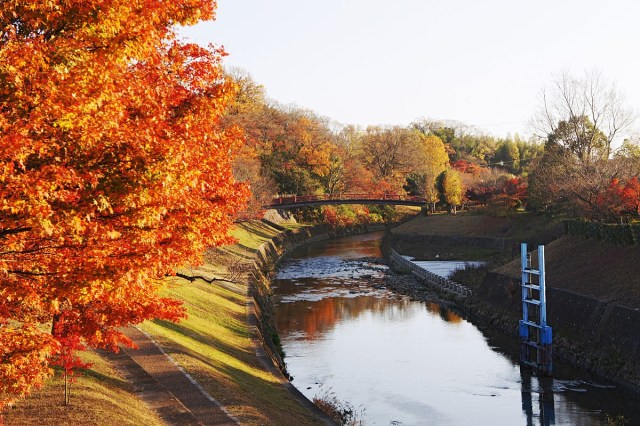
Locals in Ikoma awake to find the Tatsutagawa River has turned very verdant.
An interesting linguistic quirk of the Japanese language is that some of the things we’d call “green” in English are referred to in Japanese as being ao, which literally translates as “blue.” For example, the color of the trees in a dense forest is usually described as ao, as is the stoplight color that means “go.”
However, while ao usually means “blue” but can sometimes mean “green,” the standard word for “green,” midori, doesn’t have that same sort of flexibility. So when people in the town of Ikoma, Nara Prefecture, started calling city hall on Wednesday with reports that the Tatsutagawa River had turned midori, they meant green – and REALLY green.
For comparison, here’s what the Tatsutagawa River (which is also pictured at the top of this article) usually looks like,
https://goo.gl/maps/5xJhbG2eL7fZJHmt5
Locals first noticed the waterway had acquired a fluorescent hue at around 5 in the morning, which isn’t long after the sun comes up in midsummer in Japan. Despite its antifreeze-like color, no noticeable chemical odors were reported.
Specialists from the municipal and prefectural government were dispatched and began searching upstream, tracing the strange color to Mochigawa, a smaller waterway which feeds into the Tatsutagawa River. There they found a reddish-brown substance on a section of the smaller river’s concrete embankment which, when washed with a high-pressure hose, dissolved into a liquid with the same bright green color that the river had turned downstream, as shown in the video below.
The subsequent investigation determined the substance to be fluorescein sodium, the sodium salt of fluorescein, an organic compound that acts as a dye. Because of its bright color, fluorescein sodium is used as adiagnostic aid in both optometry and plumbing, where it helps identify injuries to the cornea and retina as well as leaks in taps or pipes. It’s also an ingredient in certain bath powders and, according to Nara Women’s University food and nutrition professor Hitoshi Takamura, a safe and legally admissible food coloring.
No injuries or medical ailments have been reported as a result of the river’s sudden shift in color. The authorities are advising local farmers and home gardeners against using the river’s water to water their plants, however, and are continuing their investigation into how so much fluorescein sodium got onto the embankment/into the river in the first place, with the working theory that it was illegally dumped by someone.
Source: NHK News Web
Top image: Wikipedia/663highland
● Want to hear about SoraNews24’s latest articles as soon as they’re published? Follow us on Facebook and Twitter!

 Kyoto’s Kamogawa River turned blood-red, and no one knows why【Video】
Kyoto’s Kamogawa River turned blood-red, and no one knows why【Video】 Photographer captures gorgeous shots of Kyoto’s Kamogawa River
Photographer captures gorgeous shots of Kyoto’s Kamogawa River Skip the crowds at Tokyo’s most popular cherry blossom spot with Meguro River Hanami Cruise
Skip the crowds at Tokyo’s most popular cherry blossom spot with Meguro River Hanami Cruise End-of-the-line exploring in Japan: Visiting Hashimoto Station
End-of-the-line exploring in Japan: Visiting Hashimoto Station Heavy snowfall in Tokyo turns the city’s borderline river into a breathtaking misty wonderland
Heavy snowfall in Tokyo turns the city’s borderline river into a breathtaking misty wonderland Foreigner’s request for help in Tokyo makes us sad for the state of society
Foreigner’s request for help in Tokyo makes us sad for the state of society Japanese city loses residents’ personal data, which was on paper being transported on a windy day
Japanese city loses residents’ personal data, which was on paper being transported on a windy day Seaside scenery, history, and so many desserts on Yokohama’s Akai Kutsu【Japan Loop Buses】
Seaside scenery, history, and so many desserts on Yokohama’s Akai Kutsu【Japan Loop Buses】 Ghibli Park now selling “Grilled Frogs” from food cart in Valley of Witches
Ghibli Park now selling “Grilled Frogs” from food cart in Valley of Witches We tried Korea’s way-too-big King Tonkatsu Burger at Lotteria 【Taste Test】
We tried Korea’s way-too-big King Tonkatsu Burger at Lotteria 【Taste Test】 Red light district sushi restaurant in Tokyo shows us just how wrong we were about it
Red light district sushi restaurant in Tokyo shows us just how wrong we were about it You don’t know Pokémon: 14 little-known facts about your favorite monster collecting series
You don’t know Pokémon: 14 little-known facts about your favorite monster collecting series Sandwiches fit for a sumo served up in Osaka【Taste Test】
Sandwiches fit for a sumo served up in Osaka【Taste Test】 Should you add tartar sauce to Japanese curry rice? CoCo Ichi makes diners an unusual offer
Should you add tartar sauce to Japanese curry rice? CoCo Ichi makes diners an unusual offer Hey, Japanese taxi driver! Take us to your favorite restaurant in Tsuruga City!
Hey, Japanese taxi driver! Take us to your favorite restaurant in Tsuruga City! McDonald’s new Happy Meals offer up cute and practical Sanrio lifestyle goods
McDonald’s new Happy Meals offer up cute and practical Sanrio lifestyle goods Japanese ramen restaurants under pressure from new yen banknotes
Japanese ramen restaurants under pressure from new yen banknotes French Fries Bread in Tokyo’s Shibuya becomes a hit on social media
French Fries Bread in Tokyo’s Shibuya becomes a hit on social media Studio Ghibli releases new action figures featuring Nausicaä of the Valley of the Wind characters
Studio Ghibli releases new action figures featuring Nausicaä of the Valley of the Wind characters New private rooms on Tokaido Shinkansen change the way we travel from Tokyo to Kyoto
New private rooms on Tokaido Shinkansen change the way we travel from Tokyo to Kyoto Tokyo Tsukiji fish market site to be redeveloped with 50,000-seat stadium, hotel, shopping center
Tokyo Tsukiji fish market site to be redeveloped with 50,000-seat stadium, hotel, shopping center Beautiful Ghibli sealing wax kits let you create accessories and elegant letter decorations【Pics】
Beautiful Ghibli sealing wax kits let you create accessories and elegant letter decorations【Pics】 Studio Ghibli releases Kiki’s Delivery Service chocolate cake pouches in Japan
Studio Ghibli releases Kiki’s Delivery Service chocolate cake pouches in Japan New definition of “Japanese whiskey” goes into effect to prevent fakes from fooling overseas buyers
New definition of “Japanese whiskey” goes into effect to prevent fakes from fooling overseas buyers Our Japanese reporter visits Costco in the U.S., finds super American and very Japanese things
Our Japanese reporter visits Costco in the U.S., finds super American and very Japanese things All-you-can-drink Starbucks and amazing views part of Tokyo’s new 170 meter-high sky lounge
All-you-can-drink Starbucks and amazing views part of Tokyo’s new 170 meter-high sky lounge More foreign tourists than ever before in history visited Japan last month
More foreign tourists than ever before in history visited Japan last month New Pokémon cakes let you eat your way through Pikachu and all the Eevee evolutions
New Pokémon cakes let you eat your way through Pikachu and all the Eevee evolutions Disney princesses get official manga makeovers for Manga Princess Cafe opening in Tokyo
Disney princesses get official manga makeovers for Manga Princess Cafe opening in Tokyo Sales of Japan’s most convenient train ticket/shopping payment cards suspended indefinitely
Sales of Japan’s most convenient train ticket/shopping payment cards suspended indefinitely Sold-out Studio Ghibli desktop humidifiers are back so Totoro can help you through the dry season
Sold-out Studio Ghibli desktop humidifiers are back so Totoro can help you through the dry season Japanese government to make first change to romanization spelling rules since the 1950s
Japanese government to make first change to romanization spelling rules since the 1950s Ghibli founders Toshio Suzuki and Hayao Miyazaki contribute to Japanese whisky Totoro label design
Ghibli founders Toshio Suzuki and Hayao Miyazaki contribute to Japanese whisky Totoro label design Doraemon found buried at sea as scene from 1993 anime becomes real life【Photos】
Doraemon found buried at sea as scene from 1993 anime becomes real life【Photos】 Tokyo’s most famous Starbucks is closed
Tokyo’s most famous Starbucks is closed One Piece characters’ nationalities revealed, but fans have mixed opinions
One Piece characters’ nationalities revealed, but fans have mixed opinions We asked a Uniqlo employee what four things we should buy and their suggestions didn’t disappoint
We asked a Uniqlo employee what four things we should buy and their suggestions didn’t disappoint Princesses, fruits, and blacksmiths: Study reveals the 30 most unusual family names in Japan
Princesses, fruits, and blacksmiths: Study reveals the 30 most unusual family names in Japan Single “Hebel Haus” is the only structure to defy the flooding of Japan’s Angry Demon River
Single “Hebel Haus” is the only structure to defy the flooding of Japan’s Angry Demon River Starbucks Japan’s new melon Frappuccino is part of a Japanese pun-themed dessert menu
Starbucks Japan’s new melon Frappuccino is part of a Japanese pun-themed dessert menu Massive storm lights up Tokyo with thousands of lightning strikes 【Pics & Videos】
Massive storm lights up Tokyo with thousands of lightning strikes 【Pics & Videos】 There’s something fishy about that catch! People in Chinese city urged not to eat floating carp
There’s something fishy about that catch! People in Chinese city urged not to eat floating carp Clever new packaging trick helps make it easier to eat instant ramen without ruining your health
Clever new packaging trick helps make it easier to eat instant ramen without ruining your health Nothing is more relaxing than watching this Japanese artist drawing with Daiso crayons【Video】
Nothing is more relaxing than watching this Japanese artist drawing with Daiso crayons【Video】 Intense rainfall suddenly floods part of Tokyo’s Asagaya neighborhood【Video】
Intense rainfall suddenly floods part of Tokyo’s Asagaya neighborhood【Video】 “Kind Chinese” vs “Greedy Chinese”: Efforts to save wild carp instantly nullified
“Kind Chinese” vs “Greedy Chinese”: Efforts to save wild carp instantly nullified The poo from Nara Park’s deer is changing because of the coronavirus pandemic
The poo from Nara Park’s deer is changing because of the coronavirus pandemic Three reasons you should go to Kyoto right now
Three reasons you should go to Kyoto right now You can make your own hot spring bath at this river in central Japan【Japan travel】
You can make your own hot spring bath at this river in central Japan【Japan travel】 Fantastically bright, green meteor in Japan caught in amazing videos
Fantastically bright, green meteor in Japan caught in amazing videos
Leave a Reply